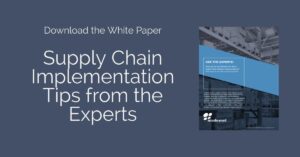
Ask any industry pro for keys to a successful solution implementation and testing for project success will always be at the top of the list, every time. The rule of thumb: test the system and then test it again. Below are some of the areas that need to be tested, and often these areas are managed by separate groups of people and skillsets.
- Testing – End-to-End Validations
- Test data – Ensure that the data you are testing is validated and accurate. This would include; Item Master, including all critical dimensions for every available Unit of Measure that will be received, stored, picked and shipped. This becomes even more critical when using dimensional data for key WMS functions, such as Order Cubing, Putaway Algorithms, Replenishment Levels, etc.
- System and Integration Testing – Integration is often the “long pole” in the tent. If integration between systems (WMS, TMS, LMS, ERP, etc.) is compromised, the Implementation will fail.
- Volume Testing – Often times, testing is done with only a small subset of orders, receipts, etc. Make sure that you “stress” the system with volume tests to ensure that all systems and interfaces will “hold the load.”
- Include a “day in life” test scenario – prepare a day’s worth of real data which can be used to cross test the system, end to end (data, integration, processes) and include your key users (shift leads) to validate the test results.
- User Acceptance Testing (UAT) – Often overlooked, or saved until last, most go-lives struggle because there was not enough User Testing. Confidence in the system will likely fail if you have not engaged the actual users.
“Every company plans some level of testing,” said John Sidell Managing Principal of New Course Group. “What’s often missed or not fully considered during the development of the implementation testing plans are the testing the organization is required to perform; the effort it takes to prepare granular test scripts and / or testing mechanisms; the level of documentation required; and the resources and man-hours required to perform each level of testing.”
Compressed timelines and failing to stress the system were shortcomings mentioned time and again by industry experts. You need an adequate timeline for testing. If you rush, you can go in with a defective project.
“A lot of times people test just the ‘happy path’ where they test how things go 90% of the time,” said enVista’s Christian Nixel. “The problem is that those 10% can have a huge negative consequence. It might start as a small problem in the WMS and snowballs in other systems.”
Setting an inflexible go-live date can cause problems, and 4SIGHT’s Greg Puckett agrees that an adequate timeline for testing is vital for success. “Full and comprehensive testing that is not compromised by a compressed or unrealistic project schedule or scope creep is key,” shared Puckett.
For more information on testing and other key tips to a successful implementation, read our white paper, “Ask the Experts: What Are the Top Mistakes You See in Supply Chain Solution Implementations?”



